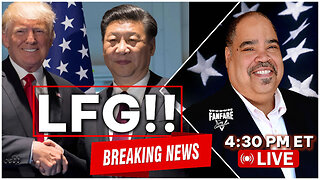Premium Only Content

Signing of the Linggajati Negotiations
Signing of the Linggajati Negotiations
Linggarjati is not only the name of an area in West Java, but also the name given to an agreement.
The Linggajati Agreement is a political agreement signed on 15 November 1946 by the Dutch government and the Republic of Indonesia.
In this agreement, the Dutch side was represented by Hubertus van Mook, while the Indonesian side was represented by Prime Minister Sutan Sjahrir.
The Linggajati Agreement is a diplomatic effort by the Indonesian government to fight for the unitary territory of the Republic of Indonesia from the clutches of the Dutch colonialists.
There were 2 specific reasons behind the negotiations at Linggarjati. First, because of the desire of the Dutch to return to power in Indonesian soil, and secondly, to resolve the protracted Indonesian-Dutch conflict.
According to the terms of the agreement, the Netherlands agreed to recognize Indonesian rule over Java, Sumatra and Madura. Indonesia would then become a state of the United States of Indonesia
which will be established no later than 1 January 1949 and form the Dutch-Indonesian Union together with the Netherlands, Suriname and the Netherlands Antilles, with the Queen of the Netherlands to be the official head of this Union.
After feeling colonialism for so long, Indonesia finally declared independence on August 17, 1945.
However, the euphoria of independence did not last long, because threats from foreign parties reappeared, namely from the Dutch.
Dutch troops who are members of NICA (Netherlands-Indies Civil Administration), come to Indonesia.
NICA took part in piggybacking on the allied forces as well as AFNEI (Allied Forces Netherlands East Indies) with the aim of disarming the defeated Japanese troops.
The suspicions of the Indonesian government and people were also proven by the fighting that took place. For example the battle on November 10 in Surabaya, the Battle of Ambarawa, and others.
Due to the prolonged conflict, the Dutch and Indonesian parties agreed to make their first diplomatic contact in the history of the two countries, with the British Government as the mediator in charge.
Negotiations were held. Indonesia and the Netherlands were invited to hold negotiations at the Hoge Veluwe on 14-15 April 1946.
However, the negotiations failed because Indonesia asked the Netherlands to recognize its sovereignty over Java, Sumatra and Madura, while the Netherlands only wanted to recognize Indonesia over Java and Madura.
After the failure in the first negotiations, the British government sent Lord Killearn to Indonesia to conclude negotiations between Indonesia and the Netherlands.
Negotiations continued on October 7, 1946 at the British Consulate General in Jakarta, Indonesia-Dutch negotiations were opened led by Lord Killearn.
These negotiations resulted in a ceasefire agreement (14 October) and paved the way for negotiations at Linggarjati which began on 11 November 1946.
After the Dutch general election in 1946, the newly formed coalition government decided to establish a "General Commission" to begin negotiations with Indonesia
whose aim was to regulate the constitution of the Dutch East Indies in the post-World War II without liberating the colony. The leader of this commission is Wim Schermerhorn.
In these negotiations, Wim Schermerhorn and his commission and Hubertus van Mook represented the Netherlands
While Indonesia was represented by Soetan Sjahrir, A.K. Gani, Susanto Tirtoprojo, and Mohammad Roem.
Then from England was represented by Lord Killearn, who acted as a mediator in this negotiation.
The results of the negotiations at Linggarjati were signed on 15 November 1946 at the Merdeka Palace, and legally signed by the two countries on 25 March 1947.
The contents of the Linggarjati Agreement are as follows
The Netherlands recognizes de facto the Republic of Indonesia with territory covering Sumatra, Java and Madura. The Netherlands had to leave the de facto area no later than January 1, 1949
The Republic of Indonesia and the Netherlands will work together to form the United Indonesia State, one of the states of which is the Republic of Indonesia
The United Republic of Indonesia and the Netherlands will form an Indonesian-Dutch Union with the Queen of the Netherlands as its chairman.
With the existence of this Linggajati agreement, politically the Republic of Indonesia gains because there is de facto recognition.
This agreement was then officially signed on March 25, 1947 at the Bijswijk Palace (Istana Merdeka) Jakarta
-
 3:03:42
3:03:42
vivafrei
16 hours agoEp 263 Trump Trans Ban REINSTATED! Ashli Babbitt Settlement! Ex-CIA Doc SUES! Canada Election & MORE
125K147 -
 2:11:39
2:11:39
TheSaltyCracker
8 hours agoCocaineGate ReeEEEStream 05-11-25
138K218 -
 28:54
28:54
Afshin Rattansi's Going Underground
21 hours agoProf. John Mearsheimer: Israel OWNS the Trump Administration, Israel is a LIABILITY for the US
43.3K57 -
 1:05:58
1:05:58
Sarah Westall
9 hours agoNeocon Revival: Why War Hawks Like Nuland and Bolton Never Go Away w/ Joe Hoft
80.3K24 -
 3:11:14
3:11:14
Barry Cunningham
13 hours agoBREAKING NEWS: PRESIDENT TRUMP GETS DEAL DONE WITH CHINA!
84.8K72 -
 2:34:55
2:34:55
Nerdrotic
11 hours ago $8.65 earnedExpeditions into the Ancient Jungle w/ Luke Caverns | Forbidden Frontier 101
71.4K7 -
 0:50
0:50
JULIE GREEN MINISTRIES
19 hours agoHappy Mother's Day
131K162 -
 16:11
16:11
CryptoWendyO
14 hours ago $10.56 earnedAMAZING REASON CRYPTO TURNED BULLISH! BITCOIN $110,000 SOON!
101K49 -
 6:15:56
6:15:56
Total Horse Channel
1 day ago2025 Spring Showdown | May 11th | Barrel Racing Finals
112K4 -
 54:39
54:39
Athlete & Artist Show
18 hours ago $5.16 earnedThe Baddest Man In Hockey Hasn't Had A Goal Against In 6 MONTHS!
114K5